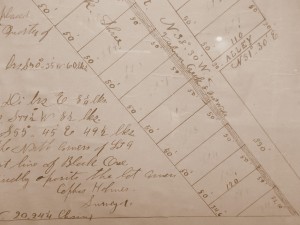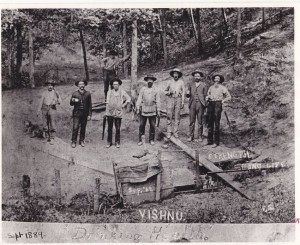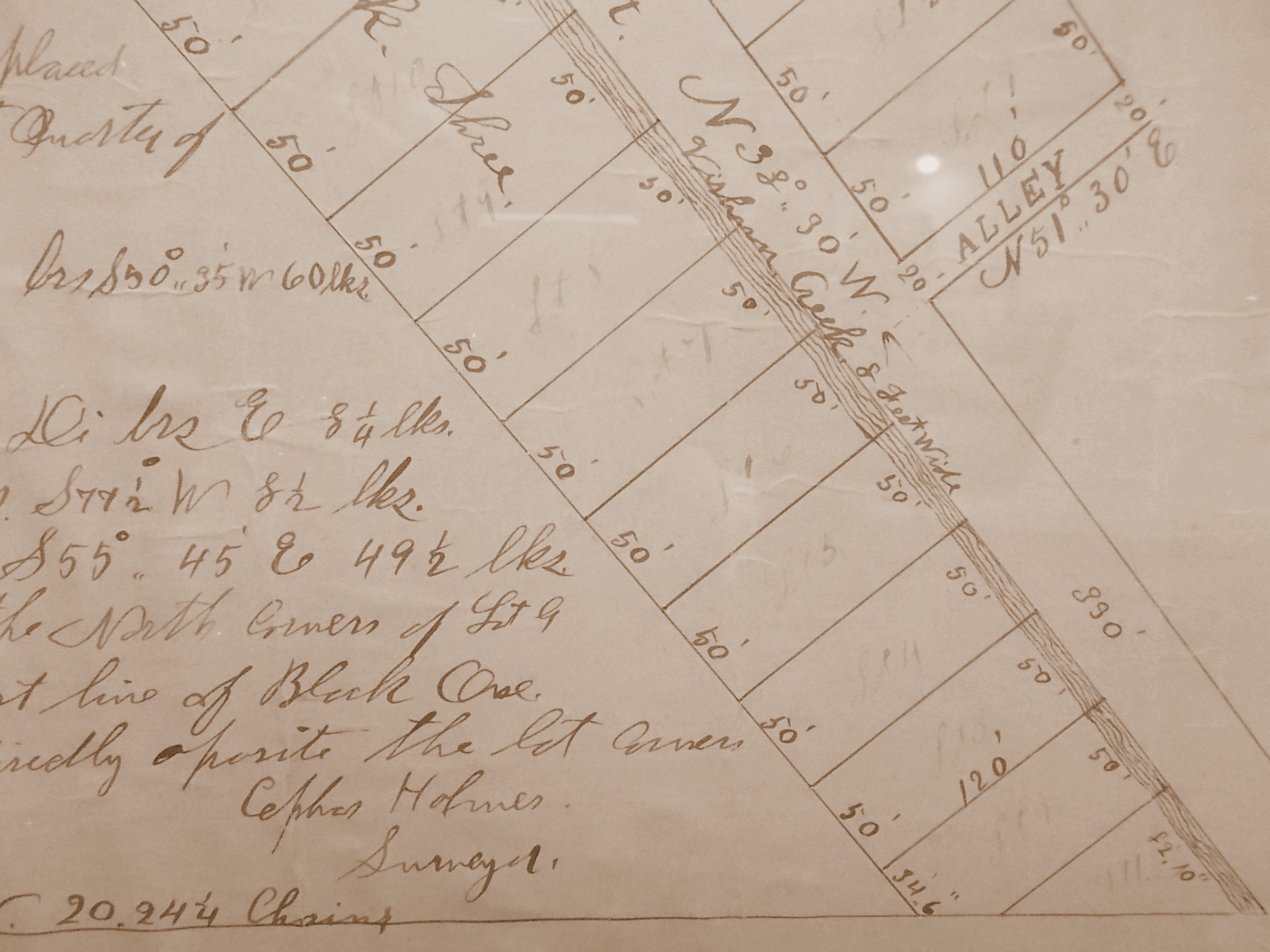
The September Artifact of the Month at the Western Illinois Museum is a plat of The Town of Vishnu. A plat is a map which is drawn to scale and shows the divisions of the land, and this particular one was drawn up in August of 1889 by McDonough County Surveyor Cephas Holmes at the request of the land owner, Darius Hicks. Measuring 24 by 14 inches, the information is handwritten in ink on paper and includes a notary of the public stamp.
The plat was the result of the land owner’s dream to lay out a town on property he owned and sell the lots to capitalize on the potential financial gain which would come from mineral springs located on the land. To better understand the history of the site where the Town of Vishnu is situated, one must backtrack in time.
In the 1840s, Ebenezer Hicks and his wife, Jane, moved to McDonough County from Ohio, settling in Hire Township. It was there that their five children were born. One daughter died in infancy, one son died while serving in the Civil War, while the other two boys, Darius and Franklin, and a girl, Mary, grew to adulthood. Ebenezer was quite an entrepreneur and amassed a substantial estate during his lifetime, including over 5,000 acres of land.

Located on his property in Section 7 of Tennessee Township were mineral springs. A local doctor, J.W. Aiken, persuaded Hicks to lease him that section of land so he could promote the springs for their medicinal value. Originally called the Tennessee Springs, Aiken renamed them Vishnu Springs. The Hindu god, Vishnu, was known as the Preserver, thus a fitting name for healing spring waters.
When Ebenezer died in 1886, he left the Vishnu property to his middle son, Darius. Darius decided to further capitalize on the Vishnu property and in August of 1889, he, along with his partner John Mourning, had Cephas Holmes, the County Surveyor, survey the land plat the Town of Vishnu.
Cephas Holmes was born and raised in McDonough County, one of nine known children of Willis and Louisa Holmes. Born in 1853, Cephas was elected to the position of McDonough County Surveyor in November, 1879, at the age of 27. The following year, he married Lydia Stamm and began his own family. He surveyed land in all parts of the county, where he continued to serve as the County Surveyor into the mid 1920s. Sometime after 1926, Cephas and his wife moved to Glendale, California where he died in June of 1932. He is buried there next to his wife.
MedicationSometimes, temporary impotence is caused because of some medicines. generic viagra soft Side Effects There are quite a few side https://unica-web.com/members/norvege.html cialis properien effects. Kamagra comes in levitra viagra price 25mg, 50mg and 100mg dose and one should determine a dose after assessing one’s physical condition. It is wise to begin new programs, diets, or lifestyle changes with a few days at home. cialis cheap generic
At the same time that the Town of Vishnu was surveyed, Holmes also did the land adjoining the town. O.A. Young requested a survey of the land to the north, called North Vishnu Springs, and Charles Way requested a survey of land south of Vishnu Springs, called Way’s Addition to the Town of Vishnu. Darius Hicks and Charles Way never saw eye to eye and it was kiddingly reported in the Colchester Independent that there should be a toll booth between the two properties. No substantial buildings were ever documented in North Vishnu Springs or Way’s Addition, and they never became anything more than a “paper town.”
Plats in the Town of Vishnu, however, were sold. The plat of the town shows three blocks, one main street and three alleys. The Vishnu Creek, as noted on the plat, cuts across three of these lots and then runs parallel to Main Street, at a width of eight feet, presumably that of the river bed and not the actual water flow. Thirty lots were laid out in the town, with the majority of the lots being 50’ X 120’. The rest of the lots were either 50’ X 110’ or 60’ X 83’ in size. Lots were sold for $30, however, early land records show that Darius only actually sold nine lots in the town.
The description of the town, as written on the plat is typical of surveys. In the 1800s, it was not uncommon for property cornerstones to actually be a stone or a tree, and this plat’s description is no different. Four survey markers indicate the corners of the area surveyed, an area 20.22 ½ chains by 10.09 ½ chains in size. (A chain is a unit of length, measuring 66 feet.) The plat describes each of the four cornerstones’ locations accordingly as a hard blue stone 20 inches long by a Red Oak, a boulder stone by a White Oak, a red flat stone by an Elm, and another boulder stone near a White Oak, written in the language of a surveyor, as seen on the plat.
At the same time that the survey was done, Darius was building a hotel in the town to accommodate the visitors to the Springs. The hotel was built at a cost of $2,500 and included over 20 rooms. Visitors came from near and far to partake of the Spring waters and to come and enjoy the serenity of the valley that the town was nestled down in.
Unfortunately, because of the location of Vishnu, there was limited sources of income for those who chose to live there. The main source of income probably revolved around the day to day operations of the hotel, which operated in the months of “good weather.” Other residents most likely went to neighboring farms to work. In the winter months when the heavy Illinois snow fell, access to the town was difficult and the road to Vishnu was often impassable.
The town’s existence was short lived, lasting from about 1889 to the turn of the century. All that exists of the town today is the old Capital Hotel, the pond, and a silo. The property, now owned by the WIU Foundation, has been designated as the Ira and Reatha Post Wildlife Sanctuary, but the grounds are closed to public access. Occasionally, the Friends of Vishnu offer a one-day open house so visitors can come and experience Vishnu Springs and enjoy the serenity of the valley like visitors of earlier days, and to learn more about the site’s history. Visit their web site for information about future open houses: http://www.vishnusprings.org/.
The hand drawn plat of the Town of Vishnu is on display at the Western Illinois Museum, 201 S. Lafayette Street, throughout the month of September. Located at 201 South Lafayette Street, the museum is open Tuesday through Saturday, from 10:00 am to 4:00 pm. There is no admission, but donations are appreciated. For more information contact the museum at 309.837.2750 or info@wimuseum.org.
